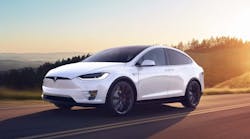Tesla Inc. was sued by the family of a man who died as the result of a crash allegedly caused when the Autopilot navigation system of his 2017 Model X malfunctioned.
The family of Walter Huang, 38, said in a complaint filed April 26 in California state court that the vehicle, which was sold as a “state-of-the-art” automobile, lacked safety features, such as an automatic emergency braking system. Such features are available on much less expensive vehicles from other carmakers, as well as on more recent Model Xs, Huang’s family said.
The family also alleges that Tesla knew, or should have known, “that the Tesla Model X was likely to cause injury to its occupants by leaving travel lanes and striking fixed objects when used in a reasonably foreseeable manner.” The carmaker should have issued a recall or provided a warning “in light of the risk of harm,” the family said in the complaint.
Huang died because “Tesla is beta testing its Autopilot software on live drivers,” B. Mark Fong, a lawyer for the family, said in a statement. “The Huang family wants to help prevent this tragedy from happening to other drivers using Tesla vehicles or any semi-autonomous vehicles.”
Huang crashed on the morning of March 23, 2018, while driving on U.S. Highway 101 in Mountain View, Calif., when the Tesla Autopilot allegedly turned the vehicle left, straight into the concrete median. He’s survived by his wife, two children, and his parents.
The State of California Department of Transportation is also named as a defendant for failing to repair or restore a crash attenuator that had been damaged in a collision a week before Huang’s crash.
In a company blog post last year after the crash, Tesla wrote that the driver had about five seconds and 150 meters of unobstructed view of the highway barrier but took no action to avoid the collision, citing vehicle logs.
“Tesla Autopilot does not prevent all accidents -- such a standard would be impossible -- but it makes them much less likely to occur,” the company wrote in that post. “It unequivocally makes the world safer for the vehicle occupants, pedestrians and cyclists.”
Huang’s Tesla was following a lead vehicle at about 65 miles per hour 8 seconds before the crash, the National Transportation Safety Board said in a June 2018 preliminary investigative report on the crash, which did not establish a probable cause.
A second later, the car began to steer left while still following the lead vehicle. Four seconds before the crash it was no longer following the lead vehicle, the NTSB said. The Model X then accelerated to roughly 71 mph in the final three seconds before impact. The Autopilot’s cruise control system, which is designed to match the speed of a slower vehicle ahead of it, was set at 75 mph.
No pre-crash braking or evasive steering movement was detected, according to the NTSB’s summary of performance data recorded by the car. The Tesla’s battery pack was breached during the crash and the vehicle caught fire, the agency said.
By Edvard Pettersson and Dana Hull



